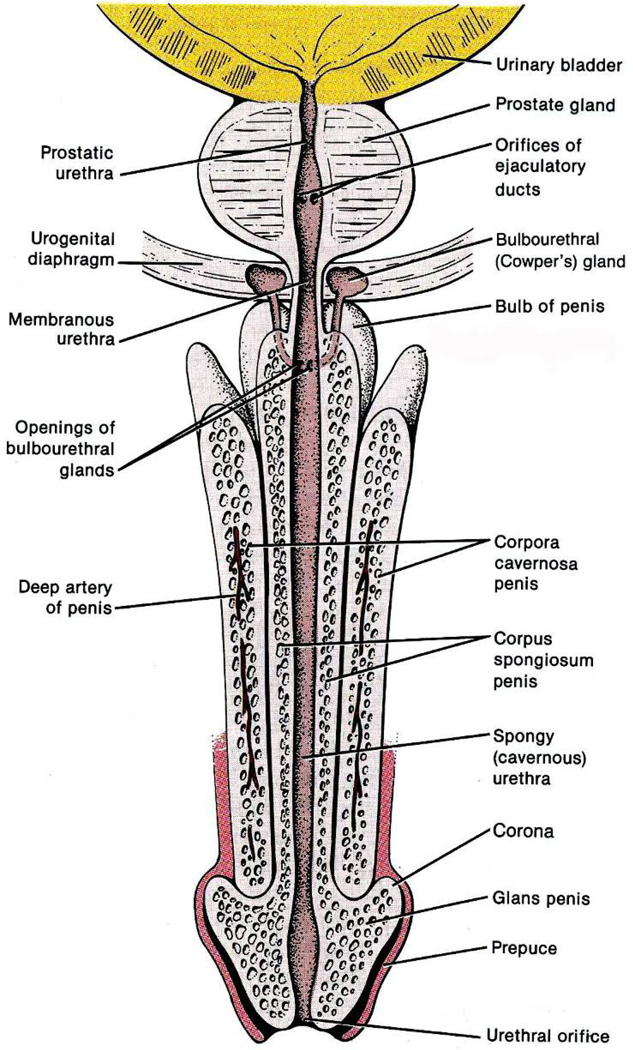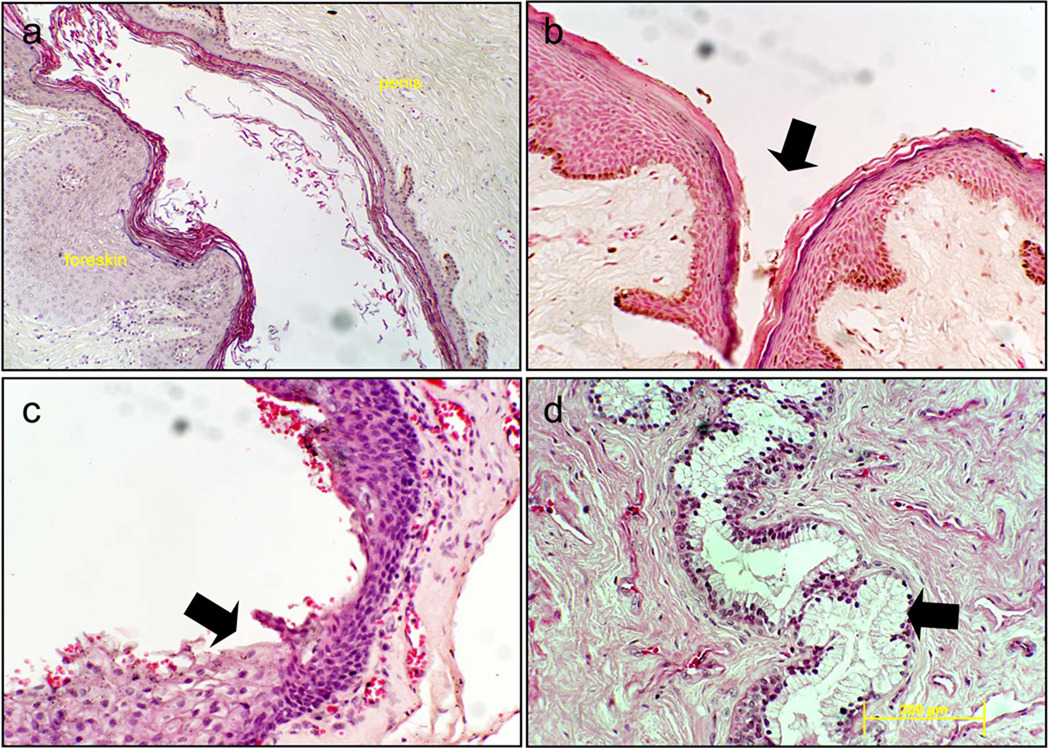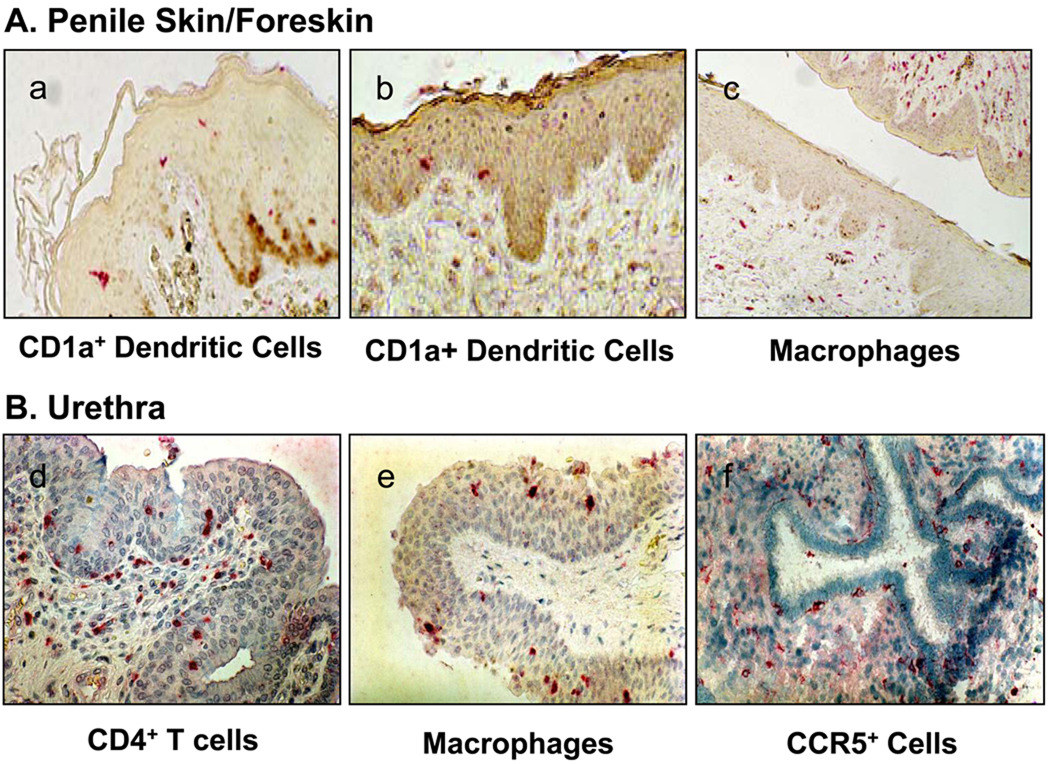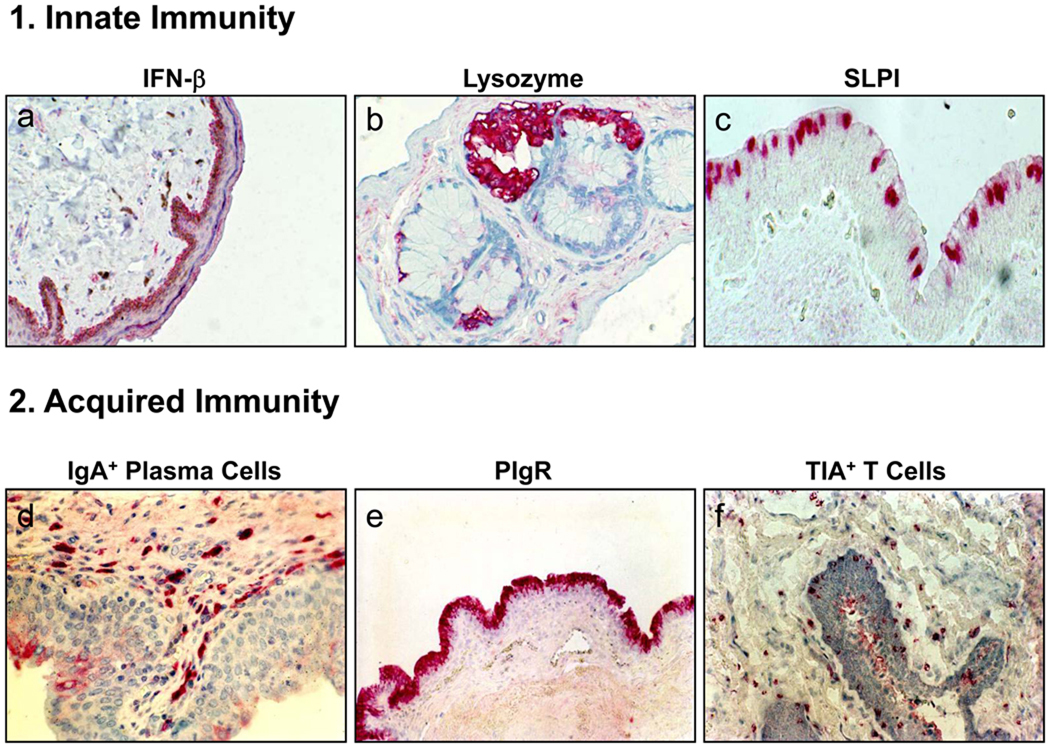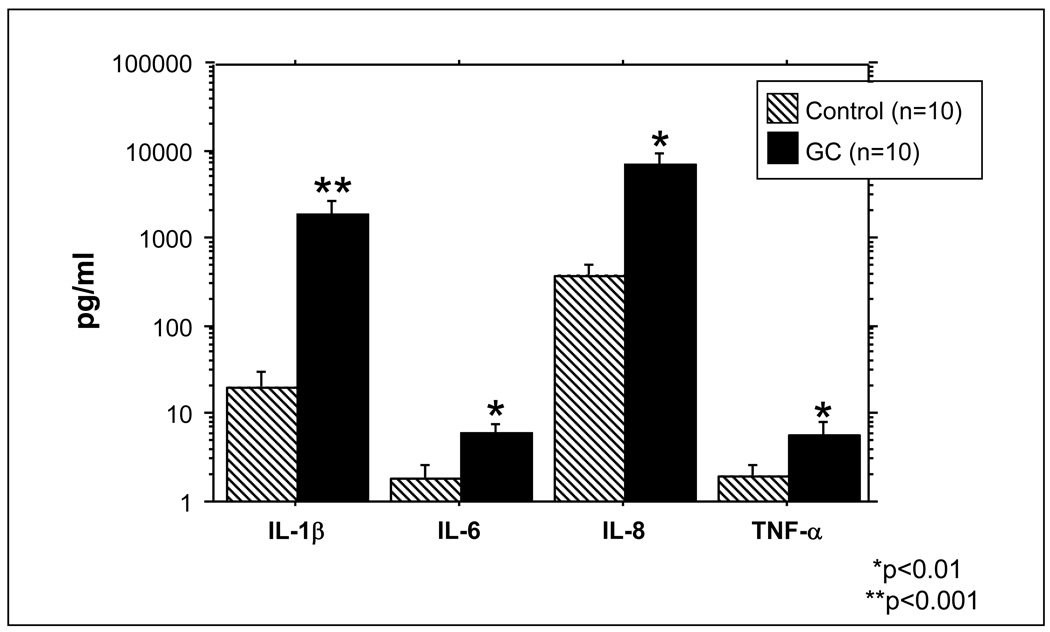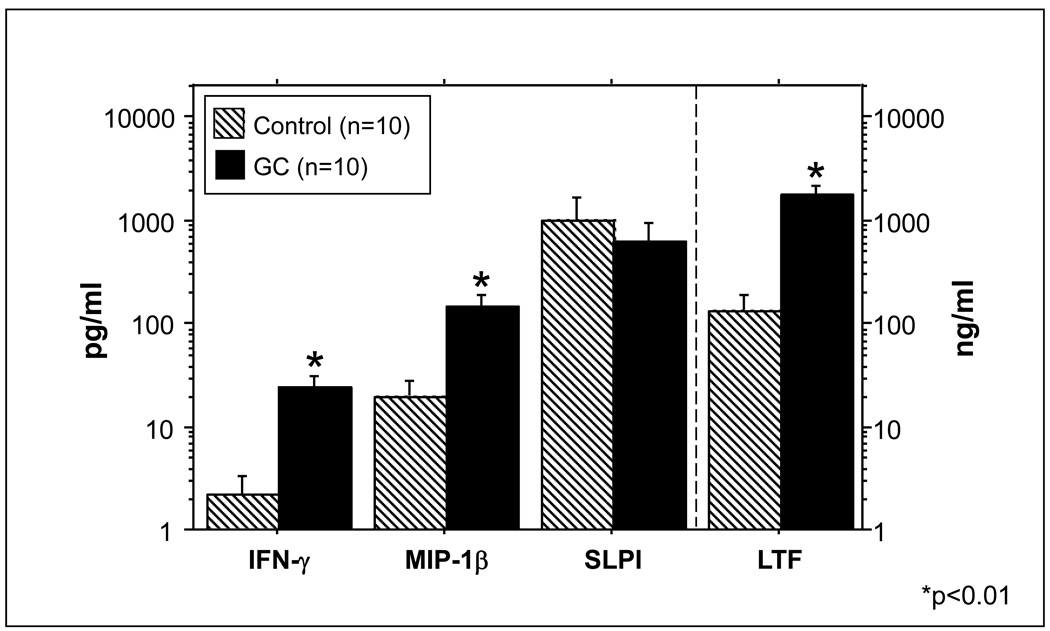Abstract
The penile foreskin, shaft, glans/corona, meatus and urethral introitus are all potential sites of HIV-1 acquisition in men. Circumcision decreases HIV infection in heterosexual men by 50–60%, indicating that the foreskin plays an important role, but that other sites are also involved. HIV target cells have been described throughout the male genital epithelium, but appear to be more accessible in the inner foreskin and urethral introitus, both of which are mucosal (wet) epithelia and infectable with HIV in vitro. Sexually transmitted co-infections can increase the risk of HIV infection at these and other sites by eroding the protective epithelial layer and by attracting and activating HIV target cells in the mucosal epithelium. The moist subpreputial cavity hosts a unique microbiome that may also play a role in HIV infection. Both innate and adaptive immune defense mechanisms are operative in the lower male genital region. The penile urethral mucosa contains accumulations of IgA+ plasma cells and T lymphocytes, and may provide a responsive target for future mucosal vaccines to prevent HIV sexual transmission.
Keywords: Penis, HIV, foreskin, urethra, sexually transmitted infections, mucosal immunology
Introduction
Over 60 million people have been infected by the human immunodeficiency virus type 1 (HIV-1) during the past 30 years, most through sexual transmission. Men comprise approximately half of the HIV-infected population worldwide, and can acquire HIV from both female and male sex partners. Sexually transmitted HIV infections in exclusively heterosexual men are acquired through the penis, whereas acquisition of HIV in men that have sex with men (MSM) can occur through the rectal or penile epithelium. The risk of female-to-male transmission is estimated to be 0.04% per unprotected exposure [95% Confidence Interval (CI): 0.01 – 0.14] in high income countries and 0.38% per act (95% CI: 0.13 – 1.10) in low income countries. The risk of male-to-male transmission is considerably higher overall (1.7% per unprotected exposure, 95% CI: 0.3 – 8.9)1.
Little is known about the mechanisms and prevention of HIV infection of the penis. In this article we will review published studies pertaining to penile HIV acquisition and identify gaps in knowledge that might be pursued in future research.
Anatomy of the human penis
A schematic of the anatomy of the penis is shown in Figure 1. The erect adult human penis averages 14 cm in length (95% CI: 10.7 – 19.1 cm) and 12.3 cm in circumference2. Based on these dimensions, the surface area of the erect penis averages approximately 200 cm2. The external surface of the nonerect penis is covered by a “dry” keratinized squamous epithelium that is relatively resistant to HIV infection unless the skin is broken, inflamed or infected (Fig 2). However, in noncircumcised men, which comprise approximately 70% of the male population worldwide3, the glans/corona and meatus of the relaxed penis are covered by a fold of skin called the foreskin or prepuce (Fig 1). The subpreputial epithelia covering the inner foreskin surface and glans/corona are mucosal “wet” epithelia that may be more susceptible to HIV infection. Recent studies indicate that the protective keratin layer may be thinner at these sites, and HIV target cells more available. Furthermore, the inner foreskin mucosal epithelium is more susceptible than outer foreskin epithelium to HIV infection in vitro (described in more detail below). The moist subpreputial cavity in noncircumcised men is also a primary infection site for HSV, HPV and other infectious organisms that promote HIV infection4–9, and also harbors a unique proinflammatory anaerobic microflora that could increase the susceptibility of bordering mucosal epithelia to HIV infection10. The moist mucosae of the penis have been associated with HIV acquisition11. Upon erection, the foreskin fold shrinks and the inner foreskin mucosal epithelium is retracted to form part of the external penile surface. As such it is directly exposed to physical trauma and genital secretions during intercourse. After intercourse, HIV virions and infected cells from infected sexual partners may be trapped under the foreskin affording an increased opportunity for infection.
Figure 1.
Schematic of the anatomy of the human penis modified from G. J. Tortora and N. P. Anagnostakos44.
Figure 2.
- Section through the penile skin and inner aspect of the foreskin. Both are composed of a keratinized stratified squamous epithelium.
- The meatus (arrow) is covered by a reflexion of the skin.
- The non-keratinized stratified squamous epithelium of the fossa navicularis abruptly transitions (arrow) into the pseudostratified columnar epithelium of the penile urethra.
- Penile urethra with a gland of Littre (arrow).
In circumcised men, most if not all of the mucosal foreskin epithelium is removed leaving a dry keratinized epithelial surface which is more resistant to HIV infection. Circumcision has been demonstrated in large randomized clinical trials to reduce the risk of HIV acquisition in men by 50–60%6, 12, 13.
Although underexplored, largely due to difficulty in obtaining tissue for research, the penile urethra is another potentially important HIV infection site in both noncircumcised and circumcised men. At the urethral orifice, which is approximately 0.6 – 1.2 cm in diameter, the meatus is covered by a keratinized stratified squamous reflexion of the skin (Fig 2). This transitions into the nonkeratinized stratified squamous epithelium of the fossa navicularis, which then transforms into the pseudostratified columnar epithelium that lines the penile urethra (Fig 2). The mucosal epithelium at this site is enriched with immune cells including HIV target cells14. The penile urethra is approximately 20 cm long and 1–2 cm in diameter, and contains numerous mucin-producing pseudoglands called the glands of Littre (Fig 2). In the majority of noncircumcised men, the urethral orifice is covered by the foreskin when the penis is in the relaxed state15. Therefore, the entire tip of the penis including the urethral opening is exposed to the moist subprepucial microenvironment, and may be colonized by unique microflora 10, 16. HIV infection of the penile urethra could therefore be enhanced in noncircumcised men due to recruitment and activation of HIV target cells by microflora that colonize the moist epithelium. In circumcised men that lack a foreskin, the urethral orifice may be the principal site of HIV acquisition.
Susceptibility of different regions of the penis to HIV infection
Because circumcision cuts the risk of HIV acquisition in men by half, much research has focused on the foreskin as a major HIV infection site. The earliest studies to address this issue reported that the inner foreskin epithelium had a thinner protective keratin layer, more accessible HIV target cells, and was more susceptible to HIV infection (both R5 and X4 strains) in vitro than outer foreskin tissue17–19. Studies on foreskins from men with sexually transmitted infections (STIs) indicated that infections were associated with focal inflammation and increased numbers of HIV target cells19, 20. However other recent studies are beginning to question some of these findings. A study of keratin thickness in North American adult foreskins found no difference in keratin thickness between the inner and outer foreskin epithelia21, and another study of Chinese adult foreskins concluded that the inner foreskin was more keratinized than the outer foreskin epithelium22. Donoval et al23 and Hirbod et al24 did not find differences in densities and types of HIV target cells in foreskin tissue from African men with varying histories of sexually transmitted infections. Frischetti et al25 reported that foreskin tissue was infectable with R5 but not X4 HIV, whereas Ganor et al26 found that the mucosal epithelium of the inner foreskin was not readily infectable with free HIV virions, but was highly susceptible to infection by HIV-infected cells. Therefore conclusive evidence that the foreskin is the principal HIV infection site on the penis is eroding. In addition, the foreskin theory does not explain how circumcised men acquire HIV infections.
STIs increase the risk of HIV infection in men (Table 1). They may do so by disrupting the penile epithelium and by attracting and activating HIV target cells at the site of infection. Langerhans cells (LCs), which are the predominant HIV target cell in stratified squamous epithelia, appear to have a dual role in HIV acquisition depending on their activation state. Immature LCs protect against HIV-1 infection by internalizing and degrading HIV-1 viral particles27, whereas after activation by exposure to microbial products and proinflammatory cytokines, LCs are efficient mediators of HIV transmission28, 29. For example, N. gonorrhoeae organisms enhance the susceptibility of LCs to HIV infection30. Other HIV target cells including CD4+ T cells and macrophages may also be attracted to and activated by STI pathogens. N. gonorrhoeae enhances HIV infection of resting CD4+ T cells through TLR 2 activation31, and HIV-1 receptor-positive cells accumulate at HSV-2 lesions and persist for some time after the infection clears32. STIs can infect various sites along the penis, including the shaft, foreskin, glans/corona and urethra. Circumcision decreases HSV2 acquisition by 28 to 34%, HPV prevalence by 32 to 35% and the incidence of genital ulcer disease in men, which could contribute to the effect of circumcision on HIV acquisition33.
Table 1.
Effects of STIs on Penile HIV Acquisition
| STI | Ratio (95% Confidence Interval) HIV Acquisition (Men)a | Penile Infection Sites | Effect of Circumcision on STI |
|---|---|---|---|
| HPV | 1.8 (1.1–2.9)b,7 | Glans, coronal sulcus, inner foreskin, external foreskin, shaft, urethra5–7 | Reduced HPV prevalence45; Decreased detection of HPV in several penile sites46; Increased clearance of penile HPV47, 48 |
| HSV-2 | 2.7 (1.9–3.9)c,49 | Penile skin, urethra4, 8, 9 | Reduced HSV-2 incidence45 |
The data shown are from publications using different statistical methods. All ratios are adjusted.
Hazard ratio
Summary relative risk of 19 studies
Studies on HIV infection of the human penis at sites other than the foreskin have been limited by lack of availability of penile tissue. Immunohistochemistry studies of penile skin and urethral mucosal epithelium harvested at autopsy have shown that Langerhans cells are found throughout the stratified squamous epithelia (shaft, glans, meatus), whereas other types of HIV target cells, notably macrophages and αEβ7+CD4+ T cells, are present in the columnar urethral mucosa14, 18, 25. Cells present at the urethral opening also express HIV coreceptors CCR5 and CXCR434. Abundant cells expressing CCR5 are also present in the mucosa of the penile urethra (Fig 3). In the sole published study of HIV infection of various penile sites (fresh penile tissue acquired from sex change operations after long term estrogen treatment), explants of foreskin, glans, meatus and urethra were all susceptible to R5 HIV-1 infection in vitro25. Studies on HIV infection of the penile urethra and other nonforeskin sites of the human penis have been limited thus far to tissues from a small number of men from developed countries. Further studies are needed to delineate HIV target cells and infection mechanisms of penile tissues from men representing different racial and ethnic groups in HIV endemic areas, from men with different hygiene and sexual behaviors including gay men, and from men with penile/urethral inflammation and various STIs. SIV/SHIV penile infection studies could also contribute valuable insight.
Figure 3.
-
Penile skin/foreskin
-
a)CD1a+ dendritic cells in epithelium of penis.
-
b)CD1a+ dendritic cells in epithelium of foreskin.
-
c)Macrophages present in foreskin.
-
a)
-
Urethra
-
e)CD4+ T cells in the penile urethra present in the epithelium and lamina propria.
-
f)Macrophages were located primarily in the epithelium of the urethra.
-
g)CCR5+ cells were abundant and detected in the epithelium and lamina propria.
-
e)
Immunologic Protection of the Penis
Keratinized squamous epithelia are defended by innate and acquired immune defense mechanisms. We have carried out immunological studies on human adult foreskin removed for cosmetic reasons We recently profiled mucin gene expression in the foreskin35. RNA for 8 mucin genes, including the gel-forming mucin 5AC, was detected by RT-PCR in human foreskin tissue. However, we were only able to confirm expression of two mucins, Muc 1 and Muc 4, at the protein level. Muc 1 and 4 are membrane-associated mucins found at many sites throughout the male genital tract.
The predominant immune cell population in the healthy foreskin is the macrophage, found primarily in the lamina propria (Fig 3). A variable number of Langerhans cells are also found within the foreskin and penile epithelium (Fig 3). These Langerhans cells are positive for CD1a, langerin and HLA-DR. A few CD4+ lymphocytes are found in the lamina propria; by contrast, a larger number of CD8+ lymphocytes can be detected in both the lamina propria and epithelium. A majority of these lymphocytes expressed the memory marker CD45RO. Foreskin tissue was examined by immunohistology for expression of Toll-like receptors (TLR) 1–936. One sample was distinctly positive for TLR-5. TLR5+ keratinocytes were detected in the basal and suprabasal regions of the epithelium, and numerous TLR5+ cells that morphologically resembled lymphocytes were also found in the lamina propria. The foreskin was also studied for the presence of the type 1 interferons (IFN) alpha and beta. IFN-α was not detected, but many keratinocytes at the base of the epithelium and a few cells in the lamina propria expressed IFN-β (Fig 4). Cells expressing lactoferrin and lysozyme were detected in the lamina propria of the foreskin (data not shown).
Figure 4.
-
Innate immunity.
-
a)IFN-β expressed by the epithelium of the penis.
-
b)Lysozyme detected in the urethral glands of Littre.
-
c)SLPI expressed by epithelial cells of urethral mucosa.
-
a)
-
Acquired immunity.
-
d)IgA+ plasma cells were abundant in the lamina propria of the urethra.
-
e)The Poly IgR was expressed by the epithelium of the urethral muscosa.
-
f)TIA+ T cells present in the epithelium and lamina propria of the urethra.
-
d)
Little is known about the composition of foreskin secretions. It is likely that they contain mucins, as the human foreskin expresses a number of mucin genes35. It is also likely that foreskin secretions, like other mucosal secretions, contain soluble mediators of immune defense that play an important role in preventing infections at this site. The foreskin is highly vascularized and serous transudation could supply antibodies to foreskin secretions. In preliminary studies, we have detected immunoglobulins, proinflammatory cytokines and antimicrobial proteins in human foreskin secretions, providing evidence that this region is protected by mediators of innate and acquired immunity.
The penile urethra is an immunologically dynamic mucosal epithelium. We and others have begun to characterize mediators of innate immunity in urethral tissues and secretions. Several membrane–associated mucins (MUC 1, 3, 4, 13, 15, 17, and 20) were confirmed to be expressed by the urethral epithelium, and one gel-forming mucin, MUC5AC, was detected in urethral glands35. Further characterization of the structure and function of urethral mucins will be important for a complete understanding of immune defense at this site.
A large number of cells in the penile urethra express diverse TLRs36. The mucosal epithelium of the penile urethra was one of few genital tissues that expressed TLR9, a receptor that detects viral nucleic acids and plays an important role in antiviral immune defense. Immune cells in the urethral mucosal epithelium expressed a variety of TLRs. The expression of the human defensin HD-5 has been studied in the penile urethra. HD-5 was secreted as a propeptide, and its expression was upregulated by C. trachomatis and N. gonorrhoeae infections. HD-5 was activated when levels of HNP 1–3 were elevated, suggesting that neutrophils contribute key proteases to convert proHD-5 to its bioactive form in the urethra during infection37, 38. Lysozyme was often detected in the glands of Littre and in intraepithelial cells resembling macrophages (Fig 4). Lactoferrin was consistently expressed by columnar epithelial cells of the urethra. The production of lactoferrin was most prevalent in crypt-like infoldings that were present along the length of the urethral epithelium. Secretory leukocyte protease inhibitor (SLPI), a component of innate immunity that plays a role in reducing inflammation as well as inhibiting infection by bacteria, viruses and fungi, was abundantly expressed by both columnar epithelial cells and urethral glands in the penile mucosa (Fig 4).
We recently measured concentrations of SLPI and lactoferrin in urethral lavages of men with and without acute N. gonorrhoeae infections. SLPI was detected in both groups, and was not elevated in secretions from the GC group (Fig 5). Lactoferrin was also detected in both groups and was significantly elevated in urethral secretions from the GC group (Fig 5). These data provide evidence that antimicrobial proteins play an important role in limiting urethral infections.
Figure 5.
- proinflammatory cytokines in urethral secretions
- levels of antiviral factors in urethral secretions.
The penile urethral epithelium contains a full contingent of cellular mediators of adaptive immunity. In the urethra proper, CD1a+ dendritic cells are absent and macrophages are the major antigen presenting cells. Macrophages were detected mostly in the epithelium with few located in the lamina propria (Fig 3). Abundant T-lymphocytes are present in the urethral mucosa. CD8+ lymphocytes are the predominant sub-population occurring in both the epithelium and lamina propria. By contrast CD4+ lymphocytes are primarily restricted to the lamina propria (Fig 3). Large concentrations of CD45RO (memory) T lymphocytes were present in both the epithelium and lamina propria of the urethra. Many of these T lymphocytes also expressed CD103, the αEβ7 integrin that mediates adhesion of mucosal lymphocytes to epithelial cells. Urethral T lymphocytes present in the epithelium and lamina propria also expressed TIA-1, a cytotoxic granule associated protein found in lymphocytes with cytotoxic functions (Fig 3). These data indicate that the human penile urethra has classical mucosal T cell and antigen-presenting cell populations potentially capable of mounting local immune defense.
Whereas a number of animal studies have begun to characterize cellular immune responses to infections in the penile urethra39–41, few studies have been conducted on urethral samples from men with sexually transmitted infections. T lymphocytes isolated from first catch urine samples were more numerous in men with gonorrhea and chlamydia infections than from men with nongonococcal urethritis42. In a recent study from our group, urethral lavages from men with N. gonorrhoeae infections contained significantly higher concentrations of proinflammatory cytokines and antiviral factors than comparable samples from men without infections (Fig 5). It should be possible to use these collection techniques to more fully describe cellular immune responses occurring at this site.
Immunoglobulin (Ig)-producing plasma cells and polymeric Ig receptor expression have also been described in the penile urethra43. Numerous IgA and IgM producing plasma cells were present in the lamina propria (Fig 4). Furthermore most of these plasma cells were positive for the presence of the J chain indicating secretion of polymeric IgA or IgM. Fewer IgG+ plasma cells compared to IgA+ plasma cells were detected in the urethra. Polymeric IgA and IgM are transported across epithelia by means of the polymeric Ig receptor (pIgR) which is mediated via the secretory component (SC). The epithelium of the urethra highly expressed the pIgR as evidenced by the intense positive staining for SC (Fig 4). Also the glands of Littre and their contents were often positive for the presence of IgA, J chain and SC. Furthermore, the mucus layer covering the surface of the urethral epithelium was also strongly positive for IgA and SC. This suggests that the mucosal secretion produced by the glands of Littre contains abundant secretory IgA and coats the epithelial surface to form an immunological barrier against invading pathogens. The stratified squamous epithelium lining the meatus and fossa navicularis did not express pIgR. Whereas few plasma cells of any phenotype were present in the meatus, numerous IgA+ and J chain+ plasma cells were observed in the mucosa of the fossa navicularis.
Surprisingly little data are available concerning immunoglobulin levels and isotypes in human penile urethral secretions. Based on the immunohistologic evidence of abundant IgA+ plasma cells and polymeric Ig receptor in urethral tissues, it is likely that secretory IgA predominates in urethral secretions.
Conclusions
HIV infection and immune defense of the human penis is an understudied area of research. Much of the focus has been on foreskin tissue, but research studies should be expanded to include other tissues including the penile urethra which appears to be an important site of both HIV infection and immune defense (Table 2).
Table 2.
Major Gaps in Knowledge
| Microbiome of male genital tract |
| Effects of androgens on male genital tract mucosal immunology and HIV infection mechanisms |
| Standardized human inner foreskin and penile urethral sampling protocols |
| In vitro and animal models of urethral HIV infection and immune defense |
Acknowledgments
Supported by NIH grants PO1 AI46518, R56AI071909, R33AI076966 (DJA)
REFERENCES
- 1.Boily MC, Baggaley RF, Wang L, Masse B, White RG, Hayes RJ, Alary M. Heterosexual risk of HIV-1 infection per sexual act: systematic review and meta-analysis of observational studies. Lancet Infect Dis. 2009;9:118–129. doi: 10.1016/S1473-3099(09)70021-0. [DOI] [PMC free article] [PubMed] [Google Scholar]
- 2.Wylie KR, Eardley I. Penile size and the 'small penis syndrome'. BJU Int. 2007;99:1449–1455. doi: 10.1111/j.1464-410X.2007.06806.x. [DOI] [PubMed] [Google Scholar]
- 3.Organization/UNAIDS WH. Geneva: World Health Organization and Joint United Nations Programme on HIV/AIDS; Male circumcision: global trends and determinants of prevalence, safety and acceptability. 2007
- 4.Corey L, Wald A. Genital herpes. In: Holmes KK, Sparling PF, Stamm WE, Piot P, Wasserheit JN, Corey L, Cohen MS, Watts DH, editors. Sexually Transmitted Diseases. 4th edn. New York: McGraw-Hill; 2008. pp. 399–437. [Google Scholar]
- 5.Flores R, Beibei L, Nielson C, Abrahamsen M, Wolf K, Lee JH, Harris RB, Giuliano AR. Correlates of human papillomavirus viral load with infection site in asymptomatic men. Cancer Epidemiol Biomarkers Prev. 2008;17:3573–3576. doi: 10.1158/1055-9965.EPI-08-0467. [DOI] [PubMed] [Google Scholar]
- 6.Smith JS, Moses S, Hudgens MG, Agot K, Franceschi S, Maclean IW, Ndinya-Achola JO, Parker CB, Pugh N, Meijer CJ, Snijders PJ, Bailey RC. Human papillomavirus detection by penile site in young men from Kenya. Sex Transm Dis. 2007;34:928–934. doi: 10.1097/OLQ.0b013e318065b8ef. [DOI] [PMC free article] [PubMed] [Google Scholar]
- 7.Smith JS, Moses S, Hudgens MG, Parker CB, Agot K, Maclean I, Ndinya-Achola JO, Snijders PJ, Meijer CJ, Bailey RC. Increased risk of HIV acquisition among Kenyan men with human papillomavirus infection. J Infect Dis. 2010;201:1677–1685. doi: 10.1086/652408. [DOI] [PMC free article] [PubMed] [Google Scholar]
- 8.Srugo I, Steinberg J, Madeb R, Gershtein R, Elias I, Tal J, Nativ O. Agents of non-gonococcal urethritis in males attending an Israeli clinic for sexually transmitted diseases. Isr Med Assoc J. 2003;5:24–27. [PubMed] [Google Scholar]
- 9.Strand A, Vahlne A, Svennerholm B, Wallin J, Lycke E. Asymptomatic virus shedding in men with genital herpes infection. Scand J Infect Dis. 1986;18:195–197. doi: 10.3109/00365548609032327. [DOI] [PubMed] [Google Scholar]
- 10.Price LB, Liu CM, Johnson KE, Aziz M, Lau MK, Bowers J, Ravel J, Keim PS, Serwadda D, Wawer MJ, Gray RH. The effects of circumcision on the penis microbiome. PLoS One. 5:e8422. doi: 10.1371/journal.pone.0008422. [DOI] [PMC free article] [PubMed] [Google Scholar]
- 11.O'Farrell N, Morison L, Moodley P, Pillay K, Vanmali T, Quigley M, Hayes R, Sturm AW. Association between HIV and subpreputial penile wetness in uncircumcised men in South Africa. J Acquir Immune Defic Syndr. 2006;43:69–77. doi: 10.1097/01.qai.0000225014.61192.98. [DOI] [PubMed] [Google Scholar]
- 12.Auvert B, Taljaard D, Lagarde E, Sobngwi-Tambekou J, Sitta R, Puren A. Randomized, controlled intervention trial of male circumcision for reduction of HIV infection risk: the ANRS 1265 Trial. PLoS Med. 2005;2:e298. doi: 10.1371/journal.pmed.0020298. [DOI] [PMC free article] [PubMed] [Google Scholar]
- 13.Gray RH, Kigozi G, Serwadda D, Makumbi F, Watya S, Nalugoda F, Kiwanuka N, Moulton LH, Chaudhary MA, Chen MZ, Sewankambo NK, Wabwire-Mangen F, Bacon MC, Williams CF, Opendi P, Reynolds SJ, Laeyendecker O, Quinn TC, Wawer MJ. Male circumcision for HIV prevention in men in Rakai, Uganda: a randomised trial. Lancet. 2007;369:657–666. doi: 10.1016/S0140-6736(07)60313-4. [DOI] [PubMed] [Google Scholar]
- 14.Pudney J, Anderson DJ. Immunobiology of the human penile urethra. Am J Pathol. 1995;147:155–165. [PMC free article] [PubMed] [Google Scholar]
- 15.O'Farrell N, Chung CK, Weiss HA. Foreskin length in uncircumcised men is associated with subpreputial wetness. Int J STD AIDS. 2008;19:821–823. doi: 10.1258/ijsa.2008.008106. [DOI] [PubMed] [Google Scholar]
- 16.Gunsar C, Kurutepe S, Alparslan O, Yilmaz O, Daglar Z, Sencan A, Genc A, Taneli C, Mir E. The effect of circumcision status on periurethral and glanular bacterial flora. Urol Int. 2004;72:212–215. doi: 10.1159/000077117. [DOI] [PubMed] [Google Scholar]
- 17.Hussain LA, Lehner T. Comparative investigation of Langerhans' cells and potential receptors for HIV in oral, genitourinary and rectal epithelia. Immunology. 1995;85:475–484. [PMC free article] [PubMed] [Google Scholar]
- 18.McCoombe SG, Short RV. Potential HIV-1 target cells in the human penis. AIDS. 2006;20:1491–1495. doi: 10.1097/01.aids.0000237364.11123.98. [DOI] [PubMed] [Google Scholar]
- 19.Patterson BK, Landay A, Siegel JN, Flener Z, Pessis D, Chaviano A, Bailey RC. Susceptibility to human immunodeficiency virus-1 infection of human foreskin and cervical tissue grown in explant culture. Am J Pathol. 2002;161:867–873. doi: 10.1016/S0002-9440(10)64247-2. [DOI] [PMC free article] [PubMed] [Google Scholar]
- 20.Johnson KE, Sherman ME, Ssempiija V, Tobian AA, Zenilman JM, Duggan MA, Kigozi G, Serwadda D, Wawer MJ, Quinn TC, Rabkin CS, Gray RH. Foreskin inflammation is associated with HIV and herpes simplex virus type-2 infections in Rakai, Uganda. AIDS. 2009;23:1807–1815. doi: 10.1097/QAD.0b013e32832efdf1. [DOI] [PMC free article] [PubMed] [Google Scholar]
- 21.Dinh MH, McRaven MD, Kelley Z, Penugonda S, Hope TJ. Keratinization of the adult male foreskin and implications for male circumcision. AIDS. 24:899–906. doi: 10.1097/QAD.0b013e3283367779. [DOI] [PMC free article] [PubMed] [Google Scholar]
- 22.Qin Q, Zheng XY, Wang YY, Shen HF, Sun F, Ding W. Langerhans' cell density and degree of keratinization in foreskins of Chinese preschool boys and adults. Int Urol Nephrol. 2009;41:747–753. doi: 10.1007/s11255-008-9521-x. [DOI] [PubMed] [Google Scholar]
- 23.Donoval BA, Landay AL, Moses S, Agot K, Ndinya-Achola JO, Nyagaya EA, MacLean I, Bailey RC. HIV-1 target cells in foreskins of African men with varying histories of sexually transmitted infections. Am J Clin Pathol. 2006;125:386–391. [PubMed] [Google Scholar]
- 24.Hirbod T, Bailey RC, Agot K, Moses S, Ndinya-Achola J, Murugu R, Andersson J, Nilsson J, Broliden K. Abundant expression of HIV target cells and C-type lectin receptors in the foreskin tissue of young Kenyan men. Am J Pathol. 176:2798–2805. doi: 10.2353/ajpath.2010.090926. [DOI] [PMC free article] [PubMed] [Google Scholar]
- 25.Fischetti L, Barry SM, Hope TJ, Shattock RJ. HIV-1 infection of human penile explant tissue and protection by candidate microbicides. AIDS. 2009;23:319–328. doi: 10.1097/QAD.0b013e328321b778. [DOI] [PMC free article] [PubMed] [Google Scholar]
- 26.Ganor Y, Zhou Z, Tudor D, Schmitt A, Vacher-Lavenu MC, Gibault L, Thiounn N, Tomasini J, Wolf JP, Bomsel M. Within 1 h, HIV-1 uses viral synapses to enter efficiently the inner, but not outer, foreskin mucosa and engages Langerhans-T cell conjugates. Mucosal Immunol. 3:506–522. doi: 10.1038/mi.2010.32. [DOI] [PubMed] [Google Scholar]
- 27.de Witte L, Nabatov A, Pion M, Fluitsma D, de Jong MA, de Gruijl T, Piguet V, van Kooyk Y, Geijtenbeek TB. Langerin is a natural barrier to HIV-1 transmission by Langerhans cells. Nat Med. 2007;13:367–371. doi: 10.1038/nm1541. [DOI] [PubMed] [Google Scholar]
- 28.de Jong MA, de Witte L, Oudhoff MJ, Gringhuis SI, Gallay P, Geijtenbeek TB. TNF-alpha and TLR agonists increase susceptibility to HIV-1 transmission by human Langerhans cells ex vivo. J Clin Invest. 2008;118:3440–3452. doi: 10.1172/JCI34721. [DOI] [PMC free article] [PubMed] [Google Scholar]
- 29.Fahrbach KM, Barry SM, Ayehunie S, Lamore S, Klausner M, Hope TJ. Activated CD34-derived Langerhans cells mediate transinfection with human immunodeficiency virus. J Virol. 2007;81:6858–6868. doi: 10.1128/JVI.02472-06. [DOI] [PMC free article] [PubMed] [Google Scholar]
- 30.Zhang N, Ahsan MH, Zhu L, Sambucetti LC, Purchio AF, West DB. Regulation of IkappaBalpha expression involves both NF-kappaB and the MAP kinase signaling pathways. J Inflamm (Lond) 2005;2:10. doi: 10.1186/1476-9255-2-10. [DOI] [PMC free article] [PubMed] [Google Scholar]
- 31.Ding J, Rapista A, Teleshova N, Mosoyan G, Jarvis GA, Klotman ME, Chang TL. Neisseria gonorrhoeae enhances HIV-1 infection of primary resting CD4+ T cells through TLR2 activation. J Immunol. 184:2814–2824. doi: 10.4049/jimmunol.0902125. [DOI] [PMC free article] [PubMed] [Google Scholar]
- 32.Zhu J, Hladik F, Woodward A, Klock A, Peng T, Johnston C, Remington M, Magaret A, Koelle DM, Wald A, Corey L. Persistence of HIV-1 receptor-positive cells after HSV-2 reactivation is a potential mechanism for increased HIV-1 acquisition. Nat Med. 2009;15:886–892. doi: 10.1038/nm.2006. [DOI] [PMC free article] [PubMed] [Google Scholar]
- 33.Tobian AA, Gray RH, Quinn TC. Male circumcision for the prevention of acquisition and transmission of sexually transmitted infections: the case for neonatal circumcision. Arch Pediatr Adolesc Med. 164:78–84. doi: 10.1001/archpediatrics.2009.232. [DOI] [PMC free article] [PubMed] [Google Scholar]
- 34.McClure CP, Tighe PJ, Robins RA, Bansal D, Bowman CA, Kingston M, Ball JK. HIV coreceptor and chemokine ligand gene expression in the male urethra and female cervix. AIDS. 2005;19:1257–1265. doi: 10.1097/01.aids.0000180096.50393.96. [DOI] [PubMed] [Google Scholar]
- 35.Russo CL, Spurr-Michaud S, Tisdale A, Pudney J, Anderson D, Gipson IK. Mucin gene expression in human male urogenital tract epithelia. Hum Reprod. 2006;21:2783–2793. doi: 10.1093/humrep/del164. [DOI] [PMC free article] [PubMed] [Google Scholar]
- 36.Pudney J, Anderson DJ. Expression of Toll-like Receptors in Genital Tract Tissues from Normal and HIV-infected Men. Am J Reprod Immunol. 2010 doi: 10.1111/j.1600-0897.2010.00877.x. [DOI] [PMC free article] [PubMed] [Google Scholar]
- 37.Porter E, Yang H, Yavagal S, Preza GC, Murillo O, Lima H, Greene S, Mahoozi L, Klein-Patel M, Diamond G, Gulati S, Ganz T, Rice PA, Quayle AJ. Distinct defensin profiles in Neisseria gonorrhoeae and Chlamydia trachomatis urethritis reveal novel epithelial cell-neutrophil interactions. Infect Immun. 2005;73:4823–4833. doi: 10.1128/IAI.73.8.4823-4833.2005. [DOI] [PMC free article] [PubMed] [Google Scholar]
- 38.Quayle AJ, Porter EM, Nussbaum AA, Wang YM, Brabec C, Yip KP, Mok SC. Gene expression, immunolocalization, and secretion of human defensin-5 in human female reproductive tract. Am J Pathol. 1998;152:1247–1258. [PMC free article] [PubMed] [Google Scholar]
- 39.Lehner T, Tao L, Panagiotidi C, Klavinskis LS, Brookes R, Hussain L, Meyers N, Adams SE, Gearing AJ, Bergmeier LA. Mucosal model of genital immunization in male rhesus macaques with a recombinant simian immunodeficiency virus p27 antigen. J Virol. 1994;68:1624–1632. doi: 10.1128/jvi.68.3.1624-1632.1994. [DOI] [PMC free article] [PubMed] [Google Scholar]
- 40.Pal S, Sarcon AK, de la Maza LM. C3H male mice with severe combined immunodeficiency cannot clear a urethral infection with a human serovar of Chlamydia trachomatis. Infect Immun. 2009;77:5602–5607. doi: 10.1128/IAI.00766-09. [DOI] [PMC free article] [PubMed] [Google Scholar]
- 41.Wang Y, Nagarajan U, Hennings L, Bowlin AK, Rank RG. Local host response to chlamydial urethral infection in male guinea pigs. Infect Immun. 2010;78:1670–1681. doi: 10.1128/IAI.01339-09. [DOI] [PMC free article] [PubMed] [Google Scholar]
- 42.Shahmanesh M, Pandit PG, Round R. Urethral lymphocyte isolation in non-gonococcal urethritis. Genitourin Med. 1996;72:362–364. doi: 10.1136/sti.72.5.362. [DOI] [PMC free article] [PubMed] [Google Scholar]
- 43.Pudney J, Anderson D. Effects of fixation and paraffin embedding on the immunohistological detection of cell-associated HIV-1 by different monoclonal antibodies. J Histochem Cytochem. 1995;43:857–862. doi: 10.1177/43.9.7543912. [DOI] [PubMed] [Google Scholar]
- 44.Tortora GJ, Anagnostakos NP. Principles of Anatomy and Physiology. 5th edn. New York: Harper and Row; 1987. [Google Scholar]
- 45.Tobian AA, Serwadda D, Quinn TC, Kigozi G, Gravitt PE, Laeyendecker O, Charvat B, Ssempijja V, Riedesel M, Oliver AE, Nowak RG, Moulton LH, Chen MZ, Reynolds SJ, Wawer MJ, Gray RH. Male circumcision for the prevention of HSV-2 and HPV infections and syphilis. N Engl J Med. 2009;360:1298–1309. doi: 10.1056/NEJMoa0802556. [DOI] [PMC free article] [PubMed] [Google Scholar]
- 46.Nielson CM, Schiaffino MK, Dunne EF, Salemi JL, Giuliano AR. Associations between male anogenital human papillomavirus infection and circumcision by anatomic site sampled and lifetime number of female sex partners. J Infect Dis. 2009;199:7–13. doi: 10.1086/595567. [DOI] [PMC free article] [PubMed] [Google Scholar]
- 47.Hernandez BY, Shvetsov YB, Goodman MT, Wilkens LR, Thompson P, Zhu X, Ning L. Reduced clearance of penile human papillomavirus infection in uncircumcised men. J Infect Dis. 2010;201:1340–1343. doi: 10.1086/651607. [DOI] [PMC free article] [PubMed] [Google Scholar]
- 48.Lu B, Wu Y, Nielson CM, Flores R, Abrahamsen M, Papenfuss M, Harris RB, Giuliano AR. Factors associated with acquisition and clearance of human papillomavirus infection in a cohort of US men: a prospective study. J Infect Dis. 2009;199:362–371. doi: 10.1086/596050. [DOI] [PubMed] [Google Scholar]
- 49.Freeman EE, Weiss HA, Glynn JR, Cross PL, Whitworth JA, Hayes RJ. Herpes simplex virus 2 infection increases HIV acquisition in men and women: systematic review and meta-analysis of longitudinal studies. AIDS. 2006;20:73–83. doi: 10.1097/01.aids.0000198081.09337.a7. [DOI] [PubMed] [Google Scholar]



